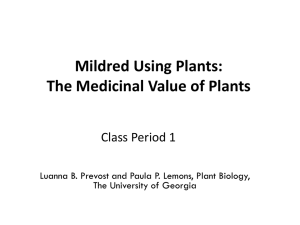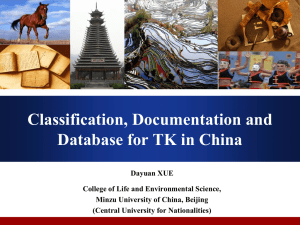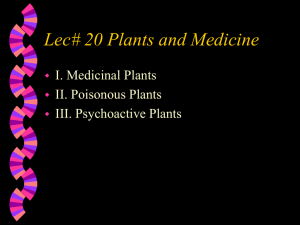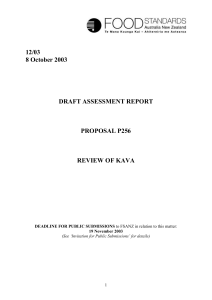Herbs for Mental and Emotional Health Brigitte Mars www
advertisement
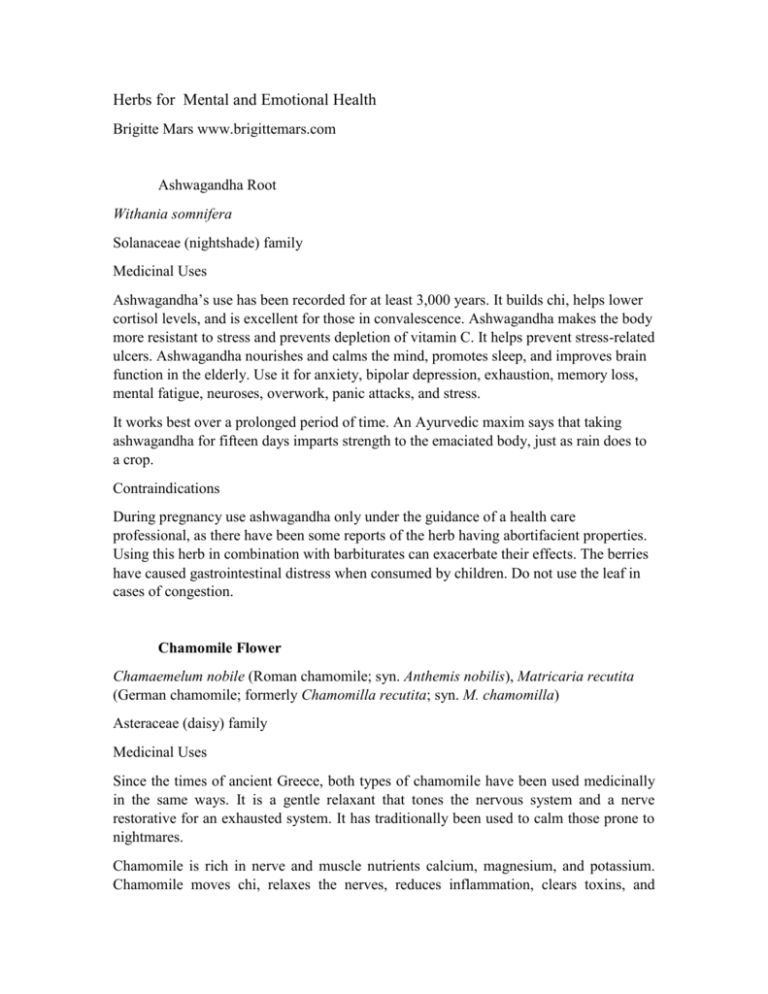
Herbs for Mental and Emotional Health Brigitte Mars www.brigittemars.com Ashwagandha Root Withania somnifera Solanaceae (nightshade) family Medicinal Uses Ashwagandha’s use has been recorded for at least 3,000 years. It builds chi, helps lower cortisol levels, and is excellent for those in convalescence. Ashwagandha makes the body more resistant to stress and prevents depletion of vitamin C. It helps prevent stress-related ulcers. Ashwagandha nourishes and calms the mind, promotes sleep, and improves brain function in the elderly. Use it for anxiety, bipolar depression, exhaustion, memory loss, mental fatigue, neuroses, overwork, panic attacks, and stress. It works best over a prolonged period of time. An Ayurvedic maxim says that taking ashwagandha for fifteen days imparts strength to the emaciated body, just as rain does to a crop. Contraindications During pregnancy use ashwagandha only under the guidance of a health care professional, as there have been some reports of the herb having abortifacient properties. Using this herb in combination with barbiturates can exacerbate their effects. The berries have caused gastrointestinal distress when consumed by children. Do not use the leaf in cases of congestion. Chamomile Flower Chamaemelum nobile (Roman chamomile; syn. Anthemis nobilis), Matricaria recutita (German chamomile; formerly Chamomilla recutita; syn. M. chamomilla) Asteraceae (daisy) family Medicinal Uses Since the times of ancient Greece, both types of chamomile have been used medicinally in the same ways. It is a gentle relaxant that tones the nervous system and a nerve restorative for an exhausted system. It has traditionally been used to calm those prone to nightmares. Chamomile is rich in nerve and muscle nutrients calcium, magnesium, and potassium. Chamomile moves chi, relaxes the nerves, reduces inflammation, clears toxins, and promotes sleep. Considered a nerve restorative, it calms anxiety and stress. It’s a useful herb for those that are “bothered by almost everything.” Add chamomile tea to a child’s bath before bed to help them sleep peacefully. It helps kids to not be so whiny. Chamomile is high in muscle-relaxing calcium, magnesium, potassium, and some of the B vitamins, which are known to aid relaxation. Chamomile is known for its antiinflammatory and antispasmodic properties that can help a tense person unwind. Contraindications Some people, especially those who are sensitive to ragweed, may be severely allergic to chamomile. It can cause contact dermatitis in some individuals. Roman chamomile is more likely to cause an allergic reaction than the German variety. On the other hand, chamomile is sometimes used to treat allergies. Use the herb with caution the first time you try it. Otherwise, chamomile is considered very safe. Avoid therapeutic dosages during pregnancy. Dandelion Root Taraxacum officinale Asteraceae (daisy) family Medicinal Uses Dandelion is one of the planet’s most famous and useful weeds. This wonderful plant is a blood purifier that aids in the process of filtering and straining wastes from the bloodstream. It cools heat and clears infection from the body. It is especially useful in treating obstructions of the gallbladder, liver, pancreas, and spleen. Dandelion is also used to help clear the body of old emotions such as anger and fear that can be stored in the liver and kidneys. The leaf can be used to treat anorexia, appetite loss, bedwetting, breast cancer, candida, debility, fatigue, flatulence, hangover, high cholesterol, hypertension, hypochondria, insomnia, nervousness, and obesity. The root is used primarily for problems related to the liver and is used to treat alcoholism, allergies, anorexia, appetite loss, candida, depression, dizziness, fatigue, hangover, headache, hypertension, hypochondria, hypoglycemia, obesity, osteoarthritis, ovarian cysts, and premenstrual syndrome. As a flower essence dandelion reduces tension, especially muscular tension in the neck, back, and shoulders. It fosters spiritual openness and encourages the letting go of fear and trust in one’s own ability to cope with life. It is beneficial for those who love life but overextend themselves. Contraindications Dandelion is generally regarded as safe, even in large amounts and even during pregnancy. However, as is the case with any plant, there is always a possibility of an allergic reaction. A very few cases have been reported of abdominal discomfort, loose stools, nausea, and heartburn associated with dandelion. The fresh latex of the plant can cause contact dermatitis in some sensitive individuals. Consult with a qualified health care practitioner prior to using dandelion in cases of obstructed bile duct or gallstones. Some individuals that have gastric hyperacidity may find that excessive use of dandelion leaf aggravates the condition. Eleuthero Root Eleuthero (Eleutherococcus senticosus, E. gracilistylus)Acanthopanax, formerly Acanthopanax senticosusAraliaceae Araliaceae (ginseng) family Medicinal Uses Eleuthero has been used for centuries by tribe peoples of Siberia and the Chinese for more than 4,000 years. An ancient Chinese proverb is, “I would rather take a handful of eleuthero than a cartload of gold and jewels.” In the frigid regions of China, Russia, and Japan, reindeer, a symbol of strength and endurance, consume this plant. Russian cosmonauts since 1962 have given rations of eleuthero to help acclimate to the stresses of being weightless and living in space. Athletes, deep-sea divers, rescue workers, and explorers all use it for nourishment during times of stress. In the past forty years over 1,000 studies on eleuthero have shown that it shares many of the same therapeutic properties as Panax ginsengs. Eleuthero nourishes the adrenals. It’s considered an adaptogen and can help you acclimate to stressful situations. It improves endurance, moods, work productivity, and accuracy. It helps the body cope with stress. Use when exhausted, fatigued, and weak. Eleuthero is used in alcoholism, anxiety, chronic fatigue, and stress. Contraindications In rare cases, eleuthero may contribute to diarrhea, elevation of blood pressure, and mild blood-platelet anti-aggregation properties. Taking eleuthero too close to bedtime may interfere with sleep. Ginger Root Zingiber officinale Zingiberaceae (ginger) family Medicinal Uses Ginger has been found to be even more effective than Dramamine in curbing motion sickness, without causing drowsiness. As a digestive aid, it warms the digestive organs, stimulates digestive secretions, increases the amylase concentration in saliva, and facilitates the digestion of starches and fatty foods. It also strengthens the tissues of the heart, activates the immune system, prevents blood platelet aggregation and leukotriene formation, and inhibits prostaglandin production, thus reducing inflammation and pain. Ginger root is used in the treatment of anxiety, depression, fatigue, headache, hypertension, hypothyroidism, indigestion, obesity, and pain. Topically, ginger can be prepared as a compress and applied over arthritic joints, bunions, sore muscles, and toothaches to relieve pain; over the kidneys to relieve the pain and assist in the passage of stones; over the chest or back to relieve asthma symptoms; or over the temples to relieve headache. Ginger is wonderful in the bath in cases of chills, muscle soreness, sciatica, and poor circulation. Contraindications Although ginger can relieve morning sickness, pregnant women should not ingest more than 1 gram daily. Avoid in cases of peptic ulcers, hyperacidity, or other hot, inflammatory conditions. Avoid excessive amounts of ginger in cases of acne, eczema, or herpes. Ginger may cause adverse reactions when used in combination with anticoagulant drugs such as Coumadin or aspirin; if you are using such medications, seek the advice of a qualified health care practitioner before commencing use of ginger. Ginkgo Leaf Ginkgo biloba Ginkgoaceae (ginkgo) family Medicinal Uses Ginkgo is the oldest tree species on the planet, having been common even when dinosaurs roamed the earth! It has a high resistance to disease, insects, and pollution. It improves nerve transmission and helps the brain to better utilize oxygen and glucose. Ginkgo has been found to improve nerve signal transmission and activate ATP (adenosine triposphate), an organic compound that aids metabolic reactions. Ginkgo helps protect nerve cells from free-radical damage. In Europe it is one of the best-selling medicines and is used in the treatment of a wide variety of disorders associated with aging, including dementia, memory loss, and senility and to promote recovery from stroke. It is an antioxidant and cerebral tonic. Ginkgo leaf enhances neurotransmitter receptor binding sites and neurotransmitter metabolism. It is considered of benefit to the elderly, as it may prevent the age-related decline of serotonin. It helps relax blood vessels, improving circulation and the delivery of nutrients, including oxygen and glucose, throughout the body, including the brain. It strengthens fragile capillaries and interferes with platelet-activating factor, a protein that can trigger spasms in the lungs. Concentrated ginkgo leaf increases the synthesis of dopamine, norepinephrine, and other neurotransmitters. Ginkgo leaf can be used in the treatment of Alzheimer’s disease, anxiety, dementia, depression, fatigue, memory loss, neuropathy, and pain in the extremities. Contraindications Side effects from using unstandardized ginkgo leaves are rare. However, large amounts or concentrations have been reported to cause gastrointestinal disturbance, irritability, restlessness, and headache. Ginkgo leaf can negatively affect the blood’s ability to clot, so avoid ginkgo for at least a week before surgery; in cases of hemophilia; or in concurrence with anticoagulant drugs such as Coumadin, aspirin, or MAO inhibitors. Fruit from the female trees may cause contact dermatitis or mouth lesions. Do not eat the pulp of the fruit. It smells awful, so you won’t want to! Even standing over roasting seeds can cause eye irritation and dermatitis. Avoid long-term use of the seed, and do not take more than ten seeds at a time. Excess use may cause fever, headache, irritation of the mucous membranes and skin, or emotional irritability. Ginseng Root Panax ginseng (Asian ginseng), P. quinquefolium (American ginseng) Araliaceae (ginseng) family Medicinal Uses Asian ginseng has an incredibly long history of use in Chinese medicine, dating back some 6,000 years. It is valued especially for its restorative and energizing properties. American ginseng has properties similar to those of Asian ginseng, but it is considered to be milder and it is more likely to be prescribed for younger people. Ginseng improves energy levels and enhances mental alertness. Ginseng of either variety helps the body better utilize oxygen, spares glycogen utilization, increases cerebral circulation, helps the adrenal glands to better conserve their stores of vitamin C, aids in stabilizing blood sugar levels, helps balance hormone levels in men and women, reduces LDL (“bad” cholesterol) levels while elevating HDL (“good” cholesterol) levels, and aids in the production of DNA, RNA, interferon, and red and white blood cells. It helps the body adapt to stress and maintain normal blood pressure, glucose levels, and hormonal function. It can improve stamina, reaction time, and concentration, which makes it useful for such pursuits as studying, taking tests, long-distance driving, and meditating. It also speeds recovery time from sickness, surgery, childbirth, athletic performance, and other stressors to the body. Although the root is the primary medicinal component of the plant, the leaves of both varieties can be used to treat hangover and fever. For best effect, take ginseng between meals rather than with food. It is best not to take ginseng at night, as it could impair sleep. Contraindications Avoid ginseng in cases of heat and inflammation, such as fever, flu, pneumonia, hypertension, or constipation. Do not give to children for prolonged periods, as it may cause early sexual maturation. Avoid during pregnancy and while nursing. Do not take ginseng in conjunction with cardiac glycosides except under the guidance of a qualified health care professional. Goji Berry Lycium barbarum, L. chinense Solanaceae (nightshade) family Medicinal Uses In Asia goji berry is traditionally used as a longevity tonic that nourishes the kidneys and liver. It is known to stimulate the production of hormones, interferon, white blood cells, enzymes, and blood. It also increases levels of the antioxidant superoxide dismutase and hemoglobin while decreasing levels of lipid peroxides, and it nourishes bone marrow and helps remove toxins from the blood by strengthening the kidneys and liver. Goji berries are used in Oriental medicine to help promote cheerfulness and a long life. Goji berries are used to treat dizziness, erectile dysfunction, exhaustion, fatigue, hypoglycemia, low libido, low testosterone levels, senility, tinnitus, and vertigo. Other Uses Asian folklore claims that goji berries enhance beauty and cheerfulness when taken for long periods. Contraindications Avoid in cases of acute fever or dampness, such as diarrhea and bloating. Otherwise goji is considered very safe, even for daily consumption. Gotu Kola Leaf Centella asiatica (formerly Hydrocotyle asiatica) Apiaceae (parsley) family Medicinal Uses Gotu kola has been used in India as a cerebral and endocrine tonic. It helps to regulate serotonin and dopamine brain levels. It has a revitalizing effect on the brain cells and nerves. In Asia gotu kola has long been considered a longevity tonic. An old Singhalese proverb says of gotu kola, “Two leaves a day will keep old age away.” And there are reports of a Chinese herbalist, Li Ching Yun, who supposedly lived to be 256 years old and was a regular consumer of gotu kola. Gotu kola is known to strengthen the body’s membranes, help restore strength to the venous walls and connective tissue, calm the mind, improve neural transport, and help the body detoxify. Gotu kola is often taken as a brain tonic. On the first day of spring in Nepal, for example, gotu kola leaves are given to schoolchildren to improve their concentration and memory skills. Contraindications Large doses can cause headache, itching, stupor, and vertigo. Avoid during pregnancy, except under the guidance of a qualified health care practitioner. Avoid in cases of overactive thyroid. Hawthorn Leaf, Flower, Berry Crataegus spp. Rosaceae (rose) family Medicinal Uses Hawthorn strengthens the heart muscles, dilates the blood vessels, and improves circulation. It also calms the spirit and increases circulation to the brain. As a flower essence, hawthorn promotes the healing power of hope, love, trust, and forgiveness. It helps relieve negative feelings from the heart and encourages knowledge of the strength and resiliency of the heart. Contraindications Using hawthorn may potentiate the effects of heart medications such as beta-blockers, digoxin, or Lanoxin. If you are using heart medication, consult with a qualified health care professional before commencing use of hawthorn. Use hawthorn with caution in cases of poor digestion or acid stomach. Hawthorn’s effects are slow to manifest; the herb may need to be taken for four to eight weeks before results are observed. It is generally considered extremely safe. Hops Strobile Humulus lupulus (syn. H. americanus) Cannabaceae (hemp) family Medicinal Uses Hops clears heat and toxins, nourishes yin, restrains infection, aids digestion, calms the spirit, stabilizes the nerves, eases anxiety, and encourages sleep. Hops contains lupulin, which is considered a strong but safe, reliable sedative. It induces sleep and creates a pleasant numbing sensation. If you don’t react well to valerian, hops can be a good substitute. A hops pillow can be used to aid sleep. Fill a sachet, about 5 by 5 inches (13 by 13 cm) and sewn on three sides, with hops and tie tightly with a ribbon on the top. Insert it into a pillowcase. The calming aroma helps slumber. A pillow for children’s sleep could be filled with dill seed, fennel seed, and lavender. Both King George II and Abraham Lincoln slept with hops pillows to aid sleep. As a flower essence, hops helps stimulate physical and spiritual progress and improves group interaction. Contraindications Avoid during pregnancy and in cases of depression. Use in conjunction with pharmaceutical sedatives only under the guidance of a qualified health care professional, as it may exacerbate their effects. Fresh hops plants may cause contact dermatitis and allergic reactions in some individuals, and tiny hairs from the plant can irritate the eyes if they come in contact with them. Kava Kava Root Piper methysticum Piperaceae (pepper) family Medicinal Uses Kava kava is an ancient Polynesian remedy for insomnia and nervousness. It is often used in the islands ceremoniously as a religious ritual, to welcome guests and honor births, marriages, and business deals. It helps foster open communication and a feeling of “letting go.” Kava kava helps warm the emotions, and small amounts can produce a pleasant, euphoric sensation. It is also used for divination and to produce inspiration. It calms the heart, spinal, and peripheral nerves and respiration, reduces blood clotting, relaxes the muscles without blocking nerve signals, and calms physical tension without numbing mental processes. Taking kava kava before bed can help induce pleasant sleep and vivid dreams. Kava kava is also said to increase tolerance of pain; Aborigines often took kava kava before being tattooed, and women in labor sometimes drink kava kava juice as a calmative and to facilitate birth. Kava kava can be used to ease anger, anxiety, mild depression, fear, nervousness, pain, and restlessness. It also takes the edge off withdrawal symptoms (from alcohol, nicotine, or tranquilizers). Kava kava is fat soluble, so when preparing it as a tea, add coconut milk to the steeping solution to help the infusion assimilate kava’s compounds. Contraindications Avoid during pregnancy and while nursing, and do not give to young children. Avoid in cases of Parkinson’s disease and severe depression. Do not take in conjunction with alcohol, sedatives, tranquilizers, or antidepressants, as it can potentiate their effects. Remain aware of kava kava’s soporific effects; try to avoid driving, operating heavy machinery, or other activities that require fast reaction times after taking kava kava. On the plus side, kava kava, unlike many sedatives, is not habit forming. Daily use of kava shouldn’t exceed three months, though occasional use on an ongoing basis is fine for those in good health. Kava kava may cause the tongue, mouth, and other body parts to feel somewhat numb and rubbery temporarily; this is normal. However, excess amounts can cause disturbed vision, dilated pupils, and difficulty walking. Large doses taken for extended periods can have a cumulative effect on the liver, causing kawaism, a condition marked by a yellowish tinge to the skin, a scaly rash, apathy, anorexia, and bloodshot eyes. In Europe there have been some reports of severe liver damage resulting from use of kava kava, prompting a number of nations to ban sales of it. The problem appears to be caused by a compound, called pipermethystine, that is found in the stem peelings and leaves of the kava plant but not in the roots. Traditional kava preparations are extracted from the roots, and the peelings and leaves are discarded. However, some European pharmaceutical companies bought up the kava waste products when demand for kava extract soared in the early 2000s. The cases of liver damage appear to have involved people who took standardized extract capsules, which may have contained kava stem peelings and roots as well as chemical solvents. For this reason, avoid kava products made from the leaves or stems of the plant. The traditional tea prepared from the root appears to be quite safe. Lavender Flower Lavandula spp., including L. angustifolia (syn. L. officinalis, L. vera, L. spica), L. stoechas (French lavender), L. viridis Lamiaceae (mint) family Medicinal Uses The herb clears heat, calms nerves, and settles digestion. It can be used to treat anxiety, mild depression, fear, headache (tension or migraine), insomnia, irritability, nervousness, pain, restlessness, and stress. Simply inhaling the scent of lavender essential oil from the bottle helps prevent fainting and relieves stress and depression. Today, lavender is popular as a spirit-lifting, nerve-relaxing, calming fragrance. It is popular in baths, sachets, potpourris, sleep pillows, soaps, perfumes, and other aromatic products. It is a helpful fragrance in a birthing room, as it can help calm the laboring woman. Lavender can also be used as a bath herb to soothe cranky children. Placing a drop of lavender essential oil on the edge of the mattress of a teething baby can help calm him or her. Contraindications Avoid large doses of lavender during pregnancy, as its effect on the developing fetus has not yet been determined. Lemon Balm Herb Melissa officinalis Lamiaceae (mint) family Medicinal Uses Lemon balm was widely used in ancient Greece and Rome. Avicenna, the great Arabic physician (980–1037), said that lemon balm caused “the mind and heart to be merry.” Lemon balm clears heat, calms the heart, improves concentration, cleanses the liver, improves chi circulation, lifts the spirits, and protects the cerebrum from excess stimuli. It eases anxiety and nervousness and helps with insomnia and fatigue. The essential oil can be inhaled several times daily to ease mild depression. German studies indicate that lemon balm’s volatile oils help protect the cerebrum from excess external stimuli. It affects the limbic system and helps balance emotional states. It makes an uplifting bath herb. It is a good herb for children; a cup of tea before bed can help prevent nightmares and allow for a good night’s sleep, and it is excellent to calm the nerves and boost the mood of schoolchildren who are anxious about upcoming tests. Contraindications Lemon balm is generally considered very safe and is a favorite herb for children. It can lower thyroid function, however, which is beneficial in some cases but not for those with a hypothyroid condition. LICORICE Licorice Root Glycyrrhiza glabra (European licorice), G. inflata, G. lepidota (American licorice), G. uralensis (Chinese licorice) Apiaceae (parsley) family Medicinal Uses Licorice is one of the most commonly used herbs in Traditional Chinese Medicine. It enters all twelve meridians and harmonizes the effects of other herbs, helping to prolong their effects. In Chinese Medicine, licorice root is known as “the great harmonizer” and is often added to herbal formulas. It induces a feeling of calmness, peace, and harmony; slows response to stress; and helps exhaustion due to stress. Contraindications Avoid licorice in cases of edema, nausea, vomiting, and rapid heartbeat. Licorice is not recommended during pregnancy or in combination with steroid or digoxin medications. Large doses may cause sodium retention and potassium depletion and may be emetic. Prolonged or excessive use may elevate blood pressure and cause headache and vertigo. Continuous use is not recommended in excess of six weeks, except under the guidance of a qualified health care practitioner. Chinese licorice (G. uralensis) is said to be less likely to cause side effects than the European variety (G. glabra). All these precautions notwithstanding, licorice is often added in very small amounts to other herbal medicines, so if you are at risk, read the label. Milk Thistle Seed Silybum marianum (formerly Carduus marianus) Asteraeae (daisy) family Medicinal Uses Milk thistle seed has long been used medicinally. Milk thistle seed helps protect the liver, prevents toxins from penetrating the interior of liver cells, promotes the growth of healthy liver cells, and improves the liver’s function. It offers excellent support for the liver for those who need to take pharmaceutical drugs. Other Uses In magical traditions, milk thistle is worn as protection against negative energy and used in purifying baths. Contraindications There have been occasional reports of the seeds causing bloating or diarrhea or having a laxative effect. Motherwort Herb Leonurus cardiaca Lamiaceae (mint) family Medicinal Uses Calms without causing drowsiness. Said to make mothers more joyful and balances tendencies to “over mother.” Motherwort slows a rapid heartbeat, improves circulation, prevents blood platelet aggregation, regulates the menstrual cycle, and calms anxiety and stress that may contribute to heart problems. It is especially beneficial to women’s health. Contraindications Avoid motherwort in cases of excessive menstrual bleeding. Avoid during pregnancy (but note that motherwort can be helpful during labor, under the guidance of a qualified health professional. Nettle Leaf Urtica dioica, U. urens Urticaceae (nettle) family Medicinal Uses Nettle improves the body’s resistance to pollens, molds, and environmental pollutants. It stabilizes mast cell walls, which stops the cycle of mucous membrane hyperactivity, and it nourishes and tones the veins, improves veins’ elasticity, reduces inflammation, and helps prevent blood clots. It also helps curb the appetite, cleanses toxins from the body, and energizes, making it a motivating ally for those who seek to stay on a healthy diet. Drinking nettle tea before and after surgery helps build the blood, promotes healthy blood clotting, speeds recovery, and helps the patient reclaim his or her energy. Nettle is a highly nutritious herb that is particularly strengthening to the kidneys and builds the blood. As a flower essence, nettle is recommended in times of anger or emotional coldness that can lead to spitefulness and even cruelty. It encourages fearlessness in people who feel isolated or have been “stung” by others, helping them regain the ability to connect with others by expressing their anger. It also helps users to release stress and reestablish harmony and unity within themselves. Contraindications All fifty species of the genus Urtica can be used medicinally, but stick with the urens and dioica species unless you have consulted with local herb authorities on the safety of local varieties. Nettle is not known as stinging nettle for nothing; avoid touching or eating the fresh plant unless it is very young and/or you are very brave. Touching the fresh plant can cause a burning rash. Wearing gloves when collecting can help prevent this, but the hairs in large plants may still pierce through. A nettle sting can be soothed with a poultice of yellow dock or plantain. Eating raw nettles can cause digestive disturbances, mouth and lip irritation, and urinary problems; however, these side effects are rare when the plant is puréed before ingestion and practically nonexistent when the plant is dried. When used appropriately, nettle is considered safe, even over an extended period of time, although those with overly cold, yin-deficient conditions should not use nettle for prolonged periods. Oat Seed, Herb Avena fatua (wild oat), A. sativa (cultivated oat) Poaceae (grass) family Medicinal Uses The alkaloids in oat nourish the limbic system and motor ganglia, increasing energy levels and a sense of well-being. With its high silicon content, oat helps nourish the skin, nails, teeth, bones, and hair. It builds the blood, relaxes the nerves, and strengthens the nervous system, making tactile sensations more pleasurable. It even supports treatment of addiction, alcoholism, anxiety, mild depression, exhaustion, insomnia, nervousness, and post-traumatic stress. When consumed regularly, oat can lower cholesterol levels. As a flower essence, oat is helpful for those who are filled with uncertainty and dissatisfaction and are unable to find their life’s direction. Contraindications Those with gluten allergies should use oat with caution. Passionflower, Leaf Passiflora spp., including P. edulis (yellow passionflower), P. incarnata Passifloraceae (passionflower) family Medicinal Uses Passionflower quiets the central nervous system and slows the breakdown of neurotransmitters, serotonin, and norepinephrine. Induces mild euphoria and quiets mental chatter. Promotes peaceful sleep and reduces serotonin breakdown. For chronic worriers and restless minds. It’s safe even for children and the elderly. It is an herb of choice to relieve anger, anxiety, irritability, and stress. Passionflower was an official herb of the U.S. National Formulary from 1916 to 1936. As a flower essence, passionflower helps integrate spirituality into daily life. It also helps clear emotional confusion and relieves pain and trauma. Contraindications Large doses may cause nausea and vomiting. Avoid large doses during pregnancy. Unripe fruits have some level of toxicity and should not be consumed. Rosemary Herb MARY Rosmarinus officinalis Lamiaceae (mint) family Medicinal Uses Rosemary has a delightful aroma and a long European tradition of alleviating anxiety. Ancient Greek scholars wore laurels of rosemary when taking examinations to improve memory. This member of the mint family is said to stimulate the pineal gland, improve energy levels, and relieve stress. Rosemary also contains the nutrients calcium, magnesium, potassium, phosphorus, iron, and potassium as well as more than a dozen antioxidants. Rosemary is a nervine, rejuvenative, stimulant, and tonic. In the bath or foot bath, it rejuvenates the body and mind and also helps relieve pain and sore muscles. As a flower essence, rosemary encourages users to be less forgetful and more aware, more present in their body, and more conscious. It strengthens the heart and mind and helps users receive strength from their loved ones. Contraindications Avoid therapeutic doses during pregnancy (though using rosemary moderately to season food is safe). Though rosemary is generally considered so safe that it is a common kitchen herb, extremely large doses could cause convulsions and death. Saint-John’s-Wort Herb Hypericum spp., including H. perforatum Clusiaceae (Saint-John’s-wort) family Medicinal Uses Saint-John’s-wort has been used for over 1,000 years to treat depression. It is an official herb in the pharmacopoeias of Czechoslovakia, Poland, Romania, and Russia. It’s an antidepressant because it inhibits serotonin re-uptake. It helps heal physically damaged nerves and benefits anxiety, mild to moderate depression, fear, irritability, and melancholy. It helps heal physically damaged nerves, breaks up chi stagnation, and calms and lifts the spirit. It also promotes tissue repair, deters infection, and helps relieve pain. It can help heal damaged nerves when used internally or externally. Saint-John’s-wort’s action results in part from its ability to block the reabsorption of serotonin, and it might also enhance the body’s receptivity to light. One of its components, hypericin, increases serotonin and melatonin metabolism. Another component, hyperforin, inhibits the uptake of dopamine, serotonin, noradrenaline, gamma-aminobutyric acid (GABA), and L-glutamate, thereby allowing these neurotransmitters to persist longer in the body, which contributes to emotional stability. It has been known to restore zest to the elderly who may feel lonely and uncared for. Topically, Saint-John’s-wort can be prepared as a compress to treat pain, and nerve pain. The oil or a liniment can be used for massaging the spine, neck, and head in cases of neurological damage, arthritis, neuralgia, and sciatica. As a flower essence, Saint-John’s-wort helps calm those who feel fearful or paranoid, making them feel more protected and trusting. It can help relieve nightmares and fear of death and brings feelings of courage. Saint-John’s-wort’s effects are not instantaneous. Continued use is necessary, and as many as two to six weeks may be needed before the herb’s effects manifest. Contraindications Saint-John’s-wort should not be combined with antidepressant pharmaceuticals (for example, Celexa, Eldepryl, Marplan, Nardil, Parnate, Paxil, Prozac, or Zoloft), protease inhibitors, or organ anti-rejection drugs (such as cyclosporine), except under the guidance of a qualified health care practitioner. In fact, because Saint-John’s-wort cleanses the liver, it is best to use it with caution in conjunction with any pharmaceutical drug. Saint-John’s-wort is not recommended during pregnancy, while nursing, or for children under the age of two. It may cause photosensitivity, especially in fair-skinned individuals. There have been rare reports of dizziness, nausea, fatigue, and dry mouth from its use. Some people may experience contact dermatitis from the plant. It should not be combined with MAO-inhibiting drugs. Valerian Root Valeriana spp., including V. officinalis Valerianaceae (valerian) family Valerian calms the nerves and anxiety and eases panic. In fact, during World War I, valerian was used to treat shell shock and stress in civilians. Valerian is sometimes referred to as a “daytime sedative” because it can improve performance, concentration, and memory during the day; help you sleep better during the night; and reduce the time needed to fall asleep. It calms nerves without dulling the mind. Topically, valerian can be used as a poultice to relieve pain. Its effects are due to one of its constituents, valerenic acid, which has been shown to inhibit the action of the enzyme that breaks down GABA (gamma-aminobutyric acid), thus contributing to increased levels of calming GABA in the body. In Europe today valerian is the most common nonprescription sedative, more likely to be recommended than Xanax or Valium. One reason European physicians are likely to recommend valerian rather than Valium (which is not made from valerian) is that valerian is not dangerous to combine with alcohol, whereas Valium is. Most people will find the smell or taste of valerian objectionable and will prefer using it in capsule or tincture form rather than as a tea. Valerian is best used for two- to threeweek periods or when needed rather than on a daily basis. Large doses over long periods of time are not recommended for those with a tendency toward depression. Some individuals find valerian works for them as a stimulant. This occurs because their bodies are unable to transform the essential oils in valerian into valerianic acid, one of the main calming components. As a flower essence, valerian calms, encourages healthy sleep, and eases physical pain. It is helpful during convalescence. For those who did not receive adequate love during childhood, it lifts the spirits and fosters inner peace. Note: Avoid boiling the root when making tea, which would diminish the plant’s activity. Many find the aroma of valerian unpleasant, much like that of dirty socks. Some find that making valerian tea with raisins added to the water improves the flavor. Contraindications Large doses of valerian can cause depression, nausea, headache, and lethargy. Some individuals, especially those who are already overheated, may find valerian stimulating rather than sedating. Do not use large doses for more than three weeks in a row. Avoid during pregnancy, except in very small doses. Do not give to children under the age of three. Avoid in cases of very low blood pressure or hypoglycemia; avoid long-term use in cases of depression. Use with caution if you are going to be driving, operating heavy machinery, or undertaking other activities that require fast reaction times after taking valerian. Valerian may potentiate the effects of benzodiazepine and barbiturates. Those taking sedatives, antidepressants, or anti-anxiety medications should use valerian only under the guidance of a qualified health care professional. Wild Lettuce Herb Lactuca canadensis, L. serriola (prickly wild lettuce), L. virosa (bitter wild lettuce) Asteraceae (daisy) family Medicinal Uses Wild lettuce calms the nervous system, aids sleep, relaxes the ganglions, and relieves pain. The dried leaves can be smoked to ease pain and calm stress. Topically, wild lettuce can be prepared as a wash or included in lotions to get rid of acne. The latex can be applied topically to get rid of warts or calm the itch of poison ivy. Contraindications Wild lettuce is best used only under the guidance of a qualified health care professional. Moderate doses can cause drowsiness, while large doses can give rise to excessive sexual urges or insomnia. Very large doses can be fatal. The latex from the plant can cause eye irritation or contact dermatitis in some individuals. Wood Betony HerbGoji Stachys hyssopifolia, S. officinalis (formerly Betonica officinalis; syn. S. betonica), S. palustris (marsh betony), S. sylvatica Lamiaceae (mint) family Medicinal Uses The ancient Anglo-Saxons wore wood betony as protective charms. Wood betony breaks up chi stagnation, relaxes and strengthens the nerves, relieves pain, and promotes a more positive outlook. Wood betony can help with anxiety, exhaustion, fear, headache, insomnia, nightmares, pain, palsy, stress, and persistent and unwanted thoughts. As a flower essence, wood betony enhances pineal gland function, thus improving the user’s sense of well-being. It fosters a desire for higher principles and inner calm and can be useful for those who are dealing with excessive sexual energy. Contraindications Wood betony is generally regarded as safe. However, large doses may cause vomiting. Pregnant women should avoid large doses, except during labor, and then only under the guidance of a qualified health care practitioner. Do not confuse Stachys with another genus, Pedicularis, also known as betony, as their uses are not interchangeable.

